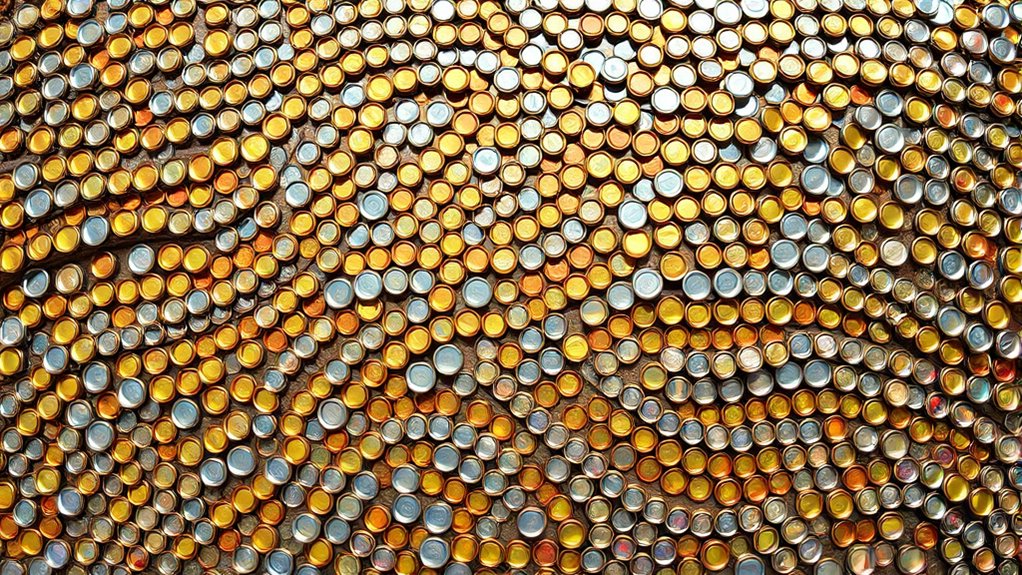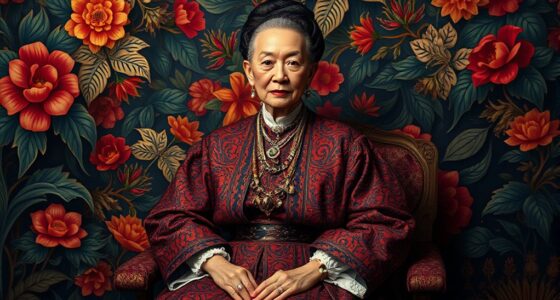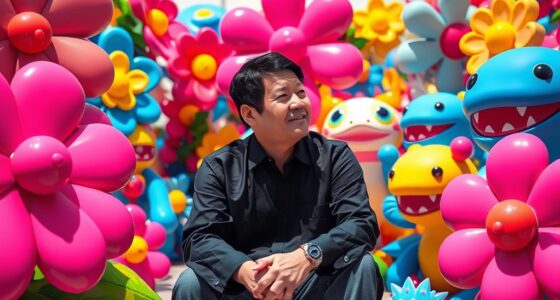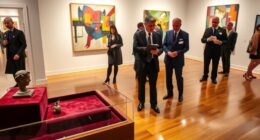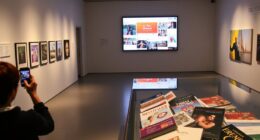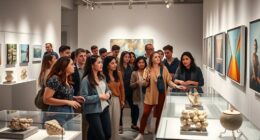El Anatsui turns recycled materials like bottle caps and metal fragments into stunning sculptures that explore cultural identity, environmental issues, and resilience. Drawing on his Ghanaian heritage and traditional motifs, he creatively reuses waste to craft intricate, textile-like works full of texture and movement. His innovative techniques and meaningful themes have earned international recognition. To discover how he transforms discarded objects into powerful art, continue exploring his inspiring journey.
Key Takeaways
- El Anatsui creatively reuses recycled materials like aluminum cans and bottle caps to craft large-scale sculptures.
- His artworks blend traditional African motifs with contemporary techniques, emphasizing cultural storytelling and resourcefulness.
- Through innovative folding, stitching, and assembly, he transforms waste into luminous, textured art pieces.
- His practice highlights environmental sustainability and social themes, reflecting cultural resilience and transformation.
- Recognized globally, he has exhibited at major venues like the Guggenheim and received prestigious awards for his mastery.
Early Life and Educational Journey
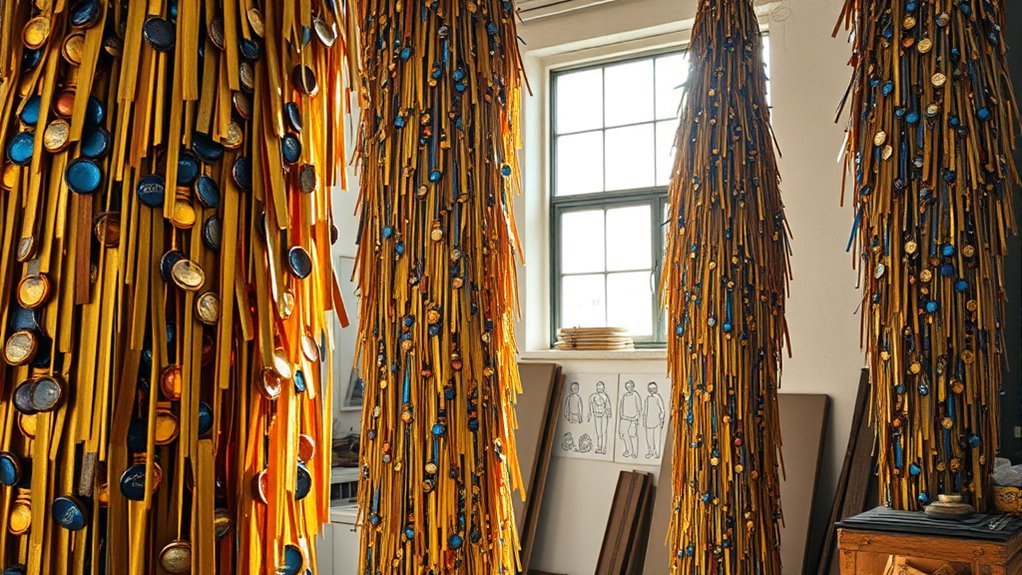
El Anatsui was born in 1944 in the small fishing town of Anyako on Ghana’s southern coast, where he grew up observing his father, a master weaver of Kente cloth, and participating in fishing and weaving activities. As the youngest of 32 children, he was immersed in traditional crafts from an early age. His mother passed away during his childhood, so he went to live with an uncle who was a Presbyterian minister, exposing him to more community and spiritual influences. He learned weaving and repetitive crafts through his family’s activities, shaping his understanding of cultural expression. Later, he studied sculpture at Kwame Nkrumah University, earning degrees in 1968 and 1969. His early experiences and education laid the foundation for his innovative artistic journey. He also studied at the College of Art, Kwame Nkrumah University of Science and Technology, Kumasi, which further expanded his artistic skills and conceptual outlook. Additionally, his exposure to global art movements helped him develop a distinctive style that combines traditional African techniques with contemporary art concepts, reflecting the influence of contemporary art on his work. Furthermore, awareness of climate control considerations in art installations has informed some of his approaches to large-scale works involving recycled materials.
Artistic Philosophy and Inspiration
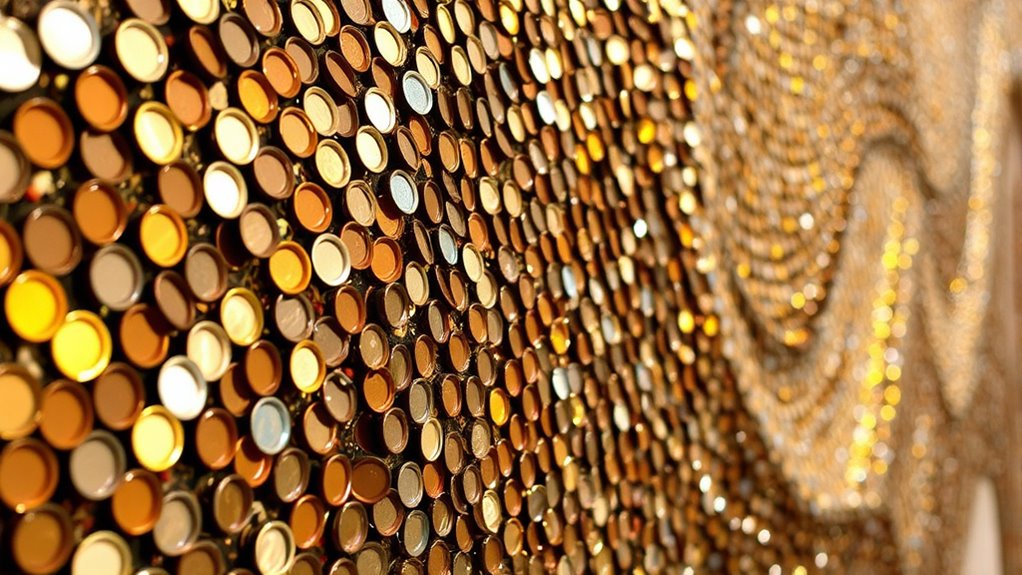
Your understanding of El Anatsui’s work begins with his embrace of recycling, turning waste into powerful artistic statements. His inspiration draws from African cultural heritage, especially symbols like Adinkra and movements like Sankofa, which reconnect him to his roots. By blending global influences with traditional themes, he creates art that celebrates identity, environmental awareness, and innovation.
Embracing Recycling Philosophy
Embracing a recycling philosophy, Anatsui transforms discarded materials into powerful works of art that carry deep cultural and social meanings. You see, he carefully selects items like bottle tops, wood, and metal—each charged with history. His process isn’t just recycling; it’s cultural transformation. His works comment on waste management issues and reflect the social lives embedded in the objects. Here’s how his approach shapes his art:
| Material Type | Significance |
|---|---|
| Bottle Tops | Symbolize consumerism and waste |
| Metal & Wood | Represent history and cultural identity |
| Found Objects | Carry social and environmental messages |
| Copper Wire | Connects materials, emphasizing transformation |
| Recycled Artworks | Promote sustainability and educational awareness |
This philosophy fuels his innovation and global recognition. Recycling philosophy also underscores the importance of sustainability in contemporary art practices. Moreover, his use of environmentally friendly materials highlights his commitment to reducing ecological impact. Additionally, his work exemplifies how cultural transformation can be achieved through innovative reuse of materials. Furthermore, integrating ecological consciousness into his art reinforces the message of environmental responsibility and social awareness.
Cultural Heritage Influence
Cultural heritage deeply informs Anatsui’s artistic philosophy and inspiration, shaping his approach to transforming recycled materials into meaningful works. You’ll notice influences from traditional African textiles like Kente cloth and Uli designs, which add richness and cultural depth. His early pieces incorporate Ghanaian symbols, reflecting a strong connection to roots and history. Anatsui’s work celebrates cultural resilience, showing how African societies adapt and transform materials over time. By blending traditional motifs with contemporary techniques, he transcends boundaries between sculpture and painting, creating dynamic, textile-like surfaces. His art captures a sense of cultural legacy, emphasizing the importance of history, identity, and storytelling. Born in Ghana, based in Nigeria, Anatsui’s work not only honors his Ghanaian heritage but also challenges viewers to think about the enduring power of cultural traditions, including the recycling of materials, as a form of artistic expression. Additionally, his use of recycled materials underscores the significance of sustainability and resourcefulness in contemporary art practices. His innovative use of materials also reflects the broader trend in IRA investing to maximize resources and minimize waste, highlighting the importance of adaptability and strategic resource management in both art and finance. Furthermore, the cultural significance of motifs and materials in his work demonstrates a deep understanding of how traditional symbols can be reinterpreted to foster dialogue between past and present. A focus on artistic innovation allows Anatsui to continuously evolve his techniques, inspiring new generations of artists to explore sustainable practices.
Global Artistic Inspirations
Anatsui’s artistic philosophy is deeply rooted in the idea that meaning extends beyond mere appearance, emphasizing abstraction and multiple interpretations. You see how his work blends African traditions with global art practices, creating hybrid forms that challenge boundaries. His influences include classical African arts and contemporary innovations, reflecting a synthesis of old and new. His art embodies the interconnectedness of cultures, telling stories of objects that have traveled across borders. This global perspective allows you to explore identity beyond ethnicity, highlighting themes of versatility and transformation. The table below illustrates some of these influences:
| African Traditions | Global Art Practices | |
|---|---|---|
| Adinkra Symbols | Contemporary Assemblage | |
| Sankofa Principle | Cross-cultural Dialogues | |
| Reclaimed Materials | Hybrid Artistic Forms | Incorporating recycled materials is central to his approach, emphasizing sustainability and cultural resilience. Anatsui’s use of material transformation exemplifies how he reimagines everyday objects into powerful art, demonstrating the significance of cultural symbolism in his work. Additionally, his innovative use of recycled materials underscores his commitment to environmental consciousness and community engagement. His work also reflects an awareness of artistic innovation, which allows him to continually evolve his artistic language and resonate with diverse audiences. |
Material Choices and Recycling Techniques

You notice how El Anatsui sources materials like bottle caps, driftwood, and metal scraps from his local environment, turning everyday waste into art. He connects these pieces using copper wire, creating flexible, large-scale sculptures that can be reconfigured easily. His techniques emphasize reuse and collaboration, transforming discarded items into powerful visual statements. Additionally, his work aligns with alternative investments strategies, showcasing innovative ways to repurpose materials for valuable artistic expression. By focusing on recycling techniques, Anatsui demonstrates how sustainable practices can be integrated into high art, inspiring viewers to reconsider waste as a resource. His approach also highlights the importance of community engagement in creating meaningful art from recycled materials. Incorporating cleaning and updating practices ensures the longevity and impact of his artwork, emphasizing the ongoing relevance of recycling in art.
Found Materials Sourcing
How does El Anatsui transform everyday discarded objects into compelling works of art? He begins by sourcing materials from local environments, like rusty cassava graters from Coal Camp near Enugu or discarded bottle caps collected from markets and scrapyards. You might assist him in gathering these items, which often seem useless but carry rich histories. He then prepares them by flattening, reshaping, and sorting—preserving rust and patina to retain their character. His choice of materials reflects cultural significance, such as bottle caps symbolizing the transatlantic slave trade. These objects embody layers of history and societal themes, transforming waste into powerful narratives. The flexibility and texture of the metals allow intricate weaving, creating dynamic visual effects that connect viewers to both local and global stories. Additionally, natural materials like wood and linen are sometimes incorporated to emphasize authenticity and a connection to the earth.
Binding and Assembly Methods
El Anatsui selects recycled aluminum, primarily from cans, for its vibrant colors and flexibility, making it ideal for his intricate designs. You’ll notice he flattens and cuts the aluminum into sheets, shaping them for assembly. Hand-stitching with copper wire is a key technique, connecting the pieces securely while adding visual contrast. Dozens of assistants help in the studio, making the process efficient. To create patterns, simple fold structures like squares or spirals are often used as starting points. The aluminum’s versatility allows for shaping through folding and prodding. For hanging, he employs foam planks, acrylic rods, and custom hardware like brass hooks and sliders, ensuring adjustability and stability. This combination of recycled materials and innovative assembly methods results in his textured, dynamic sculptures.
Signature Styles and Artistic Features
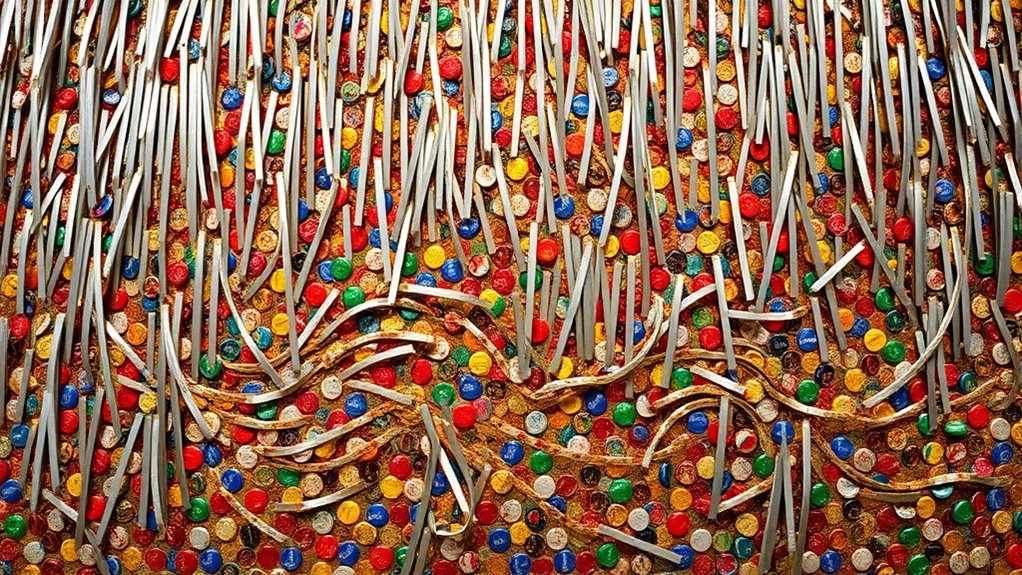
El Anatsui’s signature style seamlessly blends innovative techniques with cultural influences, creating visually stunning and thought-provoking artworks. You’ll notice his use of materials like flattened liquor bottle caps woven with copper wire, forming enormous “cloths” that shimmer and flow. His work often features:
El Anatsui’s innovative, textured sculptures blend cultural storytelling with shimmering, fluid forms.
- Textural complexity, where rough, incised markings contrast with smooth metallic surfaces.
- Luminosity and weight, giving sculptures a luminous glow while feeling substantial.
- Dynamic forms, which change with each installation, inviting interaction and exploration.
His artistic features blur boundaries—metal bound with copper wire, gestural markings made with chainsaws, and porous, porous surfaces—making each piece a unique fusion of craftsmanship and cultural storytelling. His evolving techniques continuously push the limits of sculpture and assemblage.
Cultural and Environmental Themes

Cultural and environmental themes are central to Anatsui’s work, as he transforms discarded materials into powerful symbols of identity and societal reflection. You’ll notice how his sculptures often reference African traditions like Ghanaian kente cloth and adinkra symbols, connecting past and present cultural identities. His use of recycled metals highlights issues of waste, consumption, and environmental degradation, while also emphasizing sustainability. Through motifs and patterns, Anatsui conveys stories of cultural exchange, colonial history, and social justice, blending abstract and figurative elements for deeper meaning. His choice of materials symbolizes transformation and regeneration, inspiring viewers to contemplate ecological responsibility. Overall, his work fosters awareness of cultural roots and environmental challenges, resonating globally and encouraging sustainable artistic practices.
Notable Works and International Exhibitions
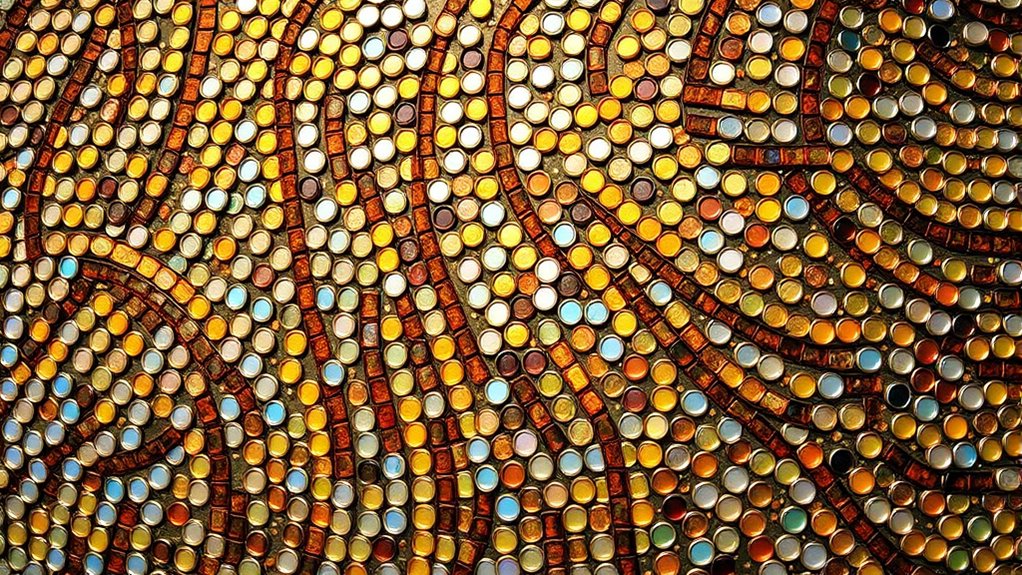
Notable works by Anatsui exemplify his mastery in transforming recycled materials into compelling art. His pieces evoke vivid imagery and cultural stories through innovative use of discarded materials. Picture:
- Man’s Cloth – a vast sculpture symbolizing heritage, crafted from shimmering metal fragments.
- Black River – a flowing, metallic form representing transformation and renewal.
- Rising Sea – an enormous copper and aluminum installation brimming with intricate detail.
His works have gained international recognition, including a spot on the 2023 Time 100 list. Exhibitions at the Guggenheim Museum and worldwide biennales showcase his boundary-breaking approach. These displays highlight his ability to create large, flexible sculptures that manipulate recycled materials into mesmerizing masterpieces, elevating recycled art to global prominence.
Impact on Contemporary Sculpture
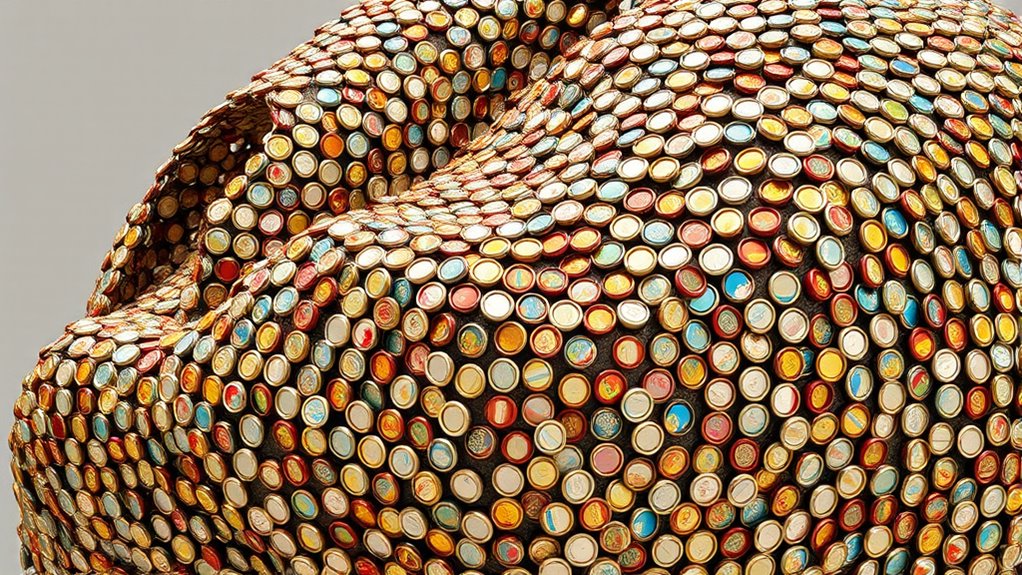
Anatsui’s innovative approach to sculpture has considerably reshaped contemporary art by expanding the boundaries of material use and form. You see discarded items like liquor bottle caps and printing plates transformed into intricate assemblages that challenge traditional sculpture materials. His work highlights waste and consumption, sparking conversations about environmental responsibility. By blending abstract influences with local aesthetic traditions, Anatsui creates a distinctive visual language that evolves with each installation, defying fixed forms. His mastery in manipulating metal—folding, crumpling, and binding with copper wire—adds texture and depth, inspiring new artistic techniques. His focus on recycled materials encourages others to explore sustainability, fostering community involvement and emphasizing the importance of environmental consciousness within the art world. Anatsui’s influence continues to push the boundaries of contemporary sculpture.
Collaborations and Community Engagement
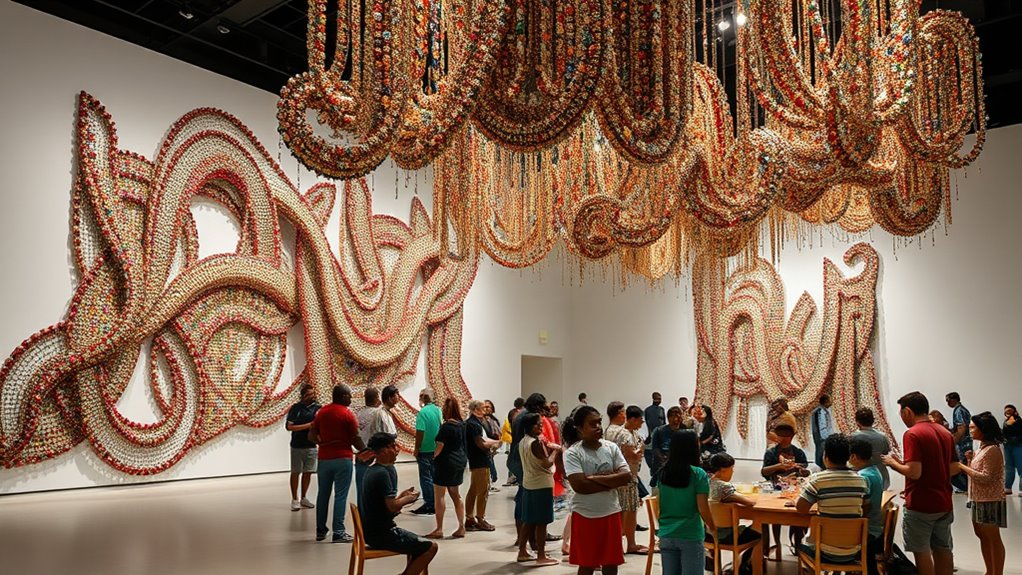
Through various collaborative exhibitions and community initiatives, El Anatsui actively engages with diverse audiences and partners worldwide. You might envision being part of:
- A vibrant group show like “Echoes of Circumstance,” where Anatsui’s work blends with others, highlighting themes of transformation and reuse.
- Educational programs and artist talks that invite local communities to explore his creative process and learn about recycled materials.
- Workshops and outreach efforts, involving community members in installing large-scale pieces and fostering cultural exchange.
These initiatives build bridges across cultures, raise environmental awareness, and make art accessible. By partnering with institutions, local artisans, and sponsors, Anatsui’s projects inspire participation and deepen understanding of his innovative, sustainable approach.
Continuing Legacy and Future Directions
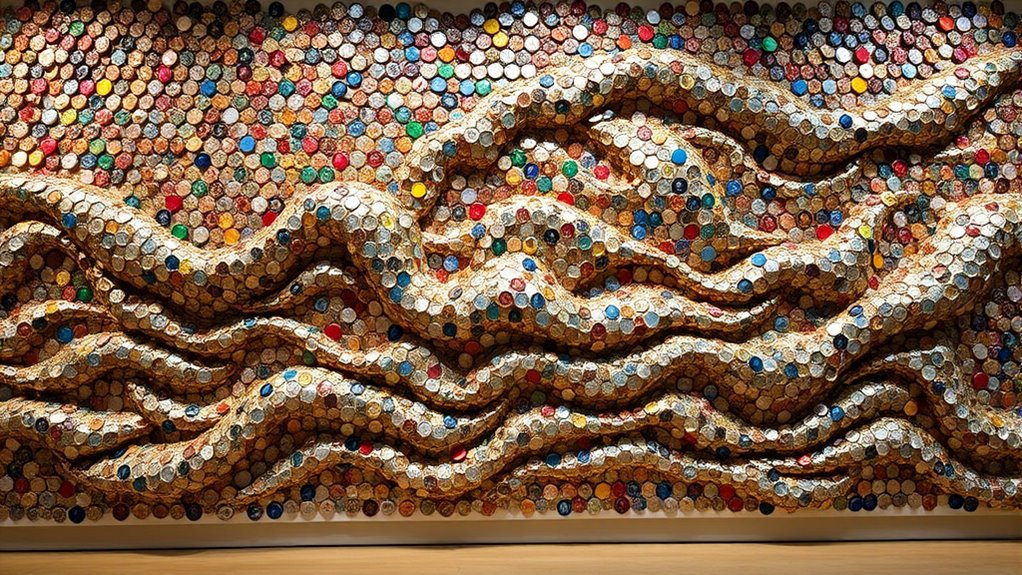
How does El Anatsui’s enduring influence shape the future of contemporary art? His legacy continues through prestigious awards like the Golden Lion for Lifetime Achievement and honors from institutions such as the Royal Academy and the American Academy of Arts and Sciences. His work’s global presence, featured in major exhibitions worldwide, cements his impact. Anatsui’s innovative use of recycled materials, transforming discarded bottle caps and printing plates into luminous sculptures, inspires emerging artists focused on sustainability. His art emphasizes environmental themes and challenges traditional sculpture, encouraging adaptability and social reflection. Future directions include commissions like the Tate Modern’s Turbine Hall installation, ensuring his influence persists. His legacy pushes the boundaries of material reuse, shaping a more conscious, environmentally aware future for contemporary art.
Frequently Asked Questions
How Does El Anatsui Choose Specific Recycled Materials for His Sculptures?
You might wonder how artists pick recycled materials for their work. They select based on their artistic vision, considering aesthetic appeal and symbolism. Local sources like scrap-metal markets or community collections influence their choices, often driven by what’s available and affordable. They manipulate these materials creatively, transforming them into intricate sculptures that reflect cultural identity, social issues, and environmental concerns, making each piece meaningful and connected to broader global themes.
What Challenges Does Anatsui Face When Working With Large-Scale Installations?
When working with large-scale installations, you face several challenges. You need to source enough materials, which can be difficult and costly. Ensuring structural support and proper weight distribution is vital to prevent collapse. Installation requires careful planning, especially in limited spaces, and managing environmental factors like lighting. Additionally, you must balance aesthetic impact with safety, all while coordinating with institutions and engaging viewers effectively.
How Does Anatsui’s Work Evolve With Changing Environmental Concerns?
You see, as environmental concerns grow louder, Anatsui’s work evolves like a mighty river reshaping landscapes. He shifts from simple recycled wood to dazzling metal tapestries, reflecting urgent issues like waste and sustainability. His art becomes a powerful voice, transforming discarded materials into symbols of cultural revival and environmental awareness. With each new piece, he challenges you to rethink waste, inspiring global change through breathtaking, innovative masterpieces.
In What Ways Does Anatsui Incorporate Local Traditions Into His Global Art Context?
You see how he blends local traditions with a global art scene by using indigenous craft items like Ghanaian trays and Igbo palm mortars as the basis for his works. His sculptures evoke African textiles such as *kente* and incorporate symbols like *adinkra*, connecting cultural heritage to contemporary art. By transforming recycled materials into tapestry-like forms, he celebrates African identity while engaging with worldwide artistic dialogues.
What Is the Significance of Copper Wire in Anatsui’s Artistic Process?
Think of copper wire as the artist’s guiding thread, weaving chaos into harmony. It binds thousands of flattened bottle caps, transforming rigid fragments into flowing, cloth-like sculptures. This wire’s flexibility allows you to shape dynamic forms, symbolizing resilience and cultural stories. Its durability guarantees your artwork stands tall over time, making copper wire essential for creating the vibrant, large-scale pieces that reflect society’s complexities and histories.
Conclusion
You’ve seen how El Anatsui transforms recycled materials into stunning masterpieces, inspiring audiences worldwide. Did you know he’s created over 50 large-scale works that explore cultural and environmental themes? His innovative use of bottle caps and aluminum waste challenges us to rethink sustainability in art. As you reflect on his impact, remember that his work not only elevates recycled materials but also sparks global conversations about creativity and ecological responsibility.

